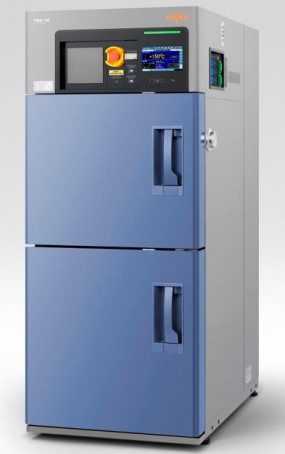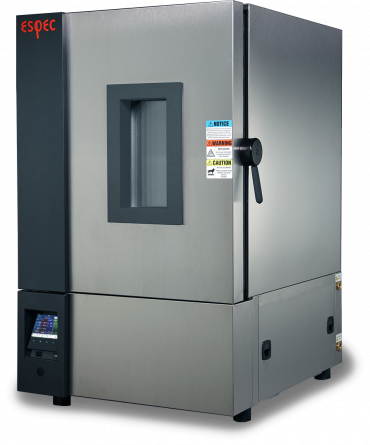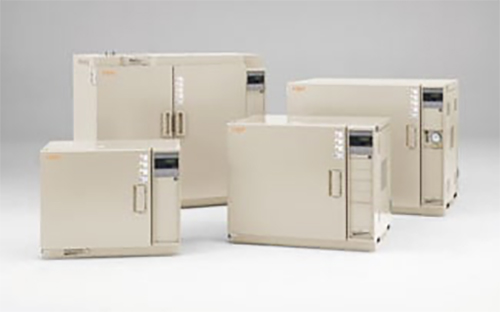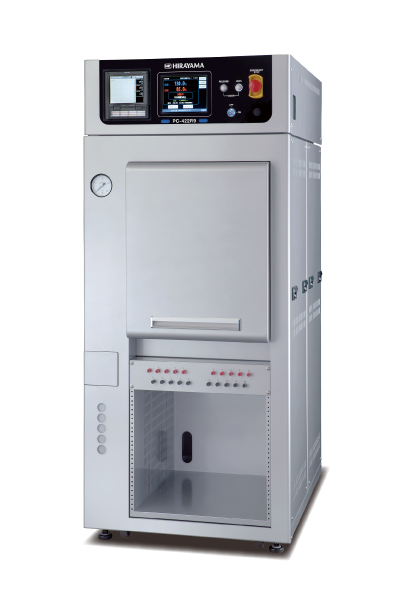Temperature Cycling
Temperature Cycling is a screening test that checks for component resistance to and durability under alternating high and low temperature extremes.
Mission conditions, especially in space applications, can shift from extreme heat to extreme cold in a short time (a satellite in orbit moving from day to night conditions, for example). Extreme shifting conditions can affect component operability as well as cause delamination, package cracking, and internal damage that could compromise a component’s operations or cause full failure.
Spirit performs Temperature Cycling as part of our screening test flows to eliminate potential component failures from a test lot before more intensive qualification testing.
Our ESPEC Thermal Shock Chamber TSE-12-A uses two temperature-controlled chambers and an elevator that moves components between chambers with minimal transfer time.
Temperature Cycling performed to MIL-STD-883 Method 1010, conditions A-E

Burn-In
Burn-in testing exposes components to temperature and electrical conditions to screen for and eliminate components that could fail due to undetected defects or weaknesses.
Burn-in is an essential reliability screening test that weeds out components that would otherwise fail earlier than expected while in operation, potentially compromising a mission. Burn-in testing stresses components to maximum application conditions. Any components that would fail early or unexpectedly are forced into failure under stress conditions.
Spirit performs both static and dynamic burn-in testing, usually as part of a screening test flow. Dynamic burn-in tests components while they are in operation under temperature and with electrical input. Static burn-in alternatively tests components in their neutral operating state without electrical input.
Burn-in screening is performed early in a test flow to remove any components from the lot that would otherwise fail during more intensive qualification tests.
Burn-in Testing Performed to MIL-STD-883 Method 1015
Devices are loaded into Spirit’s ESPEC BTL-433 temperature and humidity chamber for burn-in testing.

High Temperature Life Test
High Temperature Operating Life (HTOL) or Life Testing exposes components in operation to high temperature for an extended number of hours. This test eliminates any component failures from the test lot, but also qualifies passing components as reliably performing in extreme conditions over an extended period of time.
The extended duration of a life test, 1,000 hours or more, requires logistical planning, monitoring and support. High Temperature Operating Life (HTOL) requires careful monitoring to prevent and address interruption to the extended test conditions.
Spirit performs life tests as part of screening and qualification test flows to ensure your life test conditions are met. We can help select appropriate test conditions for accelerated testing while maintaining required exposure times.
High Temperature Operating Life Testing performed to MIL-STD-883 Method 1005 and JESD22-A108

HAST
Highly-Accelerated Stress Test (HAST) is a method of humidity and temperature testing to evaluate a component’s performance reliability and integrity over time. Exposure to extreme conditions “accelerates” the corrosive effects of moisture on the component’s leads, seals and connections. This simulates mission conditions that could result in component failure or impeded performance.
HAST testing can be biased (applying current or voltage to the component for an operating condition) or unbiased (no current or voltage applied). Biased testing stresses the component with current or voltage for operational testing, while unbiased testing can narrow down failures due only to the high humidity or temperature.
Spirit performs HAST testing to JESD22 A110 (Biased HAST) and A118 (Unbiased HAST).

Failure Protection
Products testing outside of specifications or standards pose a failure risk. Improperly leaded finishes can result in whiskering over time.
If your product fails analysis, you can take immediate action to refinish leads, or in the case of failed connection mapping, disqualify an entire lot. Ask us about our testing warranty protection to prevent failures from impacting cost and production time.

